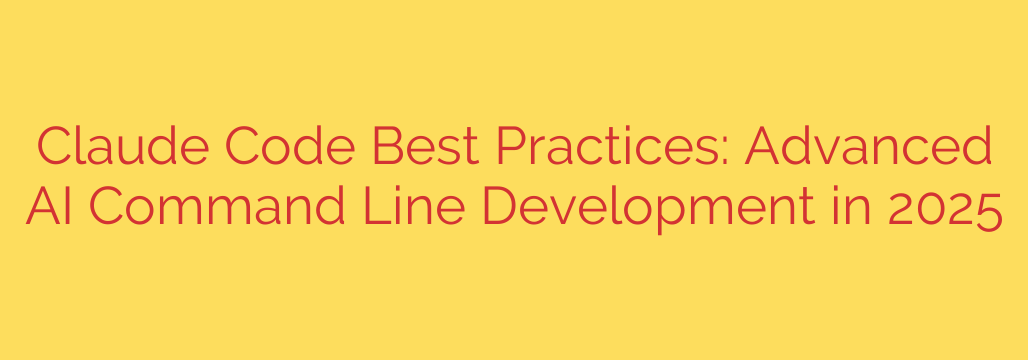
The Future of Coding is in Your Terminal: Advanced AI Command Line Techniques
For countless developers, the command line isn’t just a tool; it’s home. It’s where efficiency, power, and precision converge. Now, a new paradigm shift is bringing advanced artificial intelligence directly into this native environment, transforming the terminal into a supercharged co-pilot for coding, debugging, and system administration.
Moving beyond graphical user interfaces, integrating AI into the command line interface (CLI) unlocks unprecedented speed and automation. This guide explores the best practices for harnessing this power, helping you write better code, faster, without ever leaving your terminal.
Why the Command Line is the Ultimate AI Playground
While web-based AI chats are useful, developers gain a distinct advantage by working with AI in the CLI.
- Unmatched Speed: Execute complex commands, generate code snippets, or debug errors with a single line, eliminating the need to switch contexts between your editor, browser, and terminal.
- Seamless Integration: Pipe outputs from one command directly into an AI prompt. For example, you can feed a
git diffor acurlerror response to an AI to get an instant explanation or a suggested fix. - Powerful Automation: Combine AI capabilities with shell scripting to automate repetitive tasks, from generating boilerplate code to writing commit messages and documentation.
The Foundation: Mastering AI Prompt Engineering for Code
The quality of your AI-generated output is directly proportional to the quality of your input. When working with code, vague prompts yield generic and often unusable results. To get the most out of your AI coding assistant, focus on precision.
- Be Explicit and Specific: Instead of asking, “Write a Python script for a file,” a much better prompt is, “Write a Python 3 script that recursively searches the
/logsdirectory for files ending in.log, and for each file found, count the number of lines containing the word ‘ERROR’.” Clearly define the language, libraries, and desired outcome. - Provide Rich Context: The AI doesn’t know your project’s setup. To get relevant answers, provide relevant code snippets, error messages, and file structures. When debugging, always include the full error stack trace and the code that produced it.
- Define the Persona and Format: Instruct the AI on how to behave. For example, start your prompt with, “Act as a senior DevOps engineer.” You can also control the output format. Specify if you need the answer in JSON, a shell script, or just a code block with explanations. This saves significant time on reformatting.
Advanced Techniques for Complex Development Tasks
Once you’ve mastered basic prompting, you can move on to more sophisticated workflows that solve real-world development challenges.
Chain of Thought and Step-by-Step Decomposition
For complex problems, asking the AI to solve everything in one go can lead to errors. Instead, use a “chain of thought” approach. Ask the AI to break down the problem into smaller, manageable steps first. Then, tackle each step with a separate, focused prompt. This mimics how a human developer would approach a difficult task, leading to more accurate and reliable results.
For example: “I need to build a CI/CD pipeline for a Node.js app. First, list all the necessary stages, from linting and testing to building a Docker image and deploying it.”
Integrating with Local Tools and Commands
The true power of a CLI-based AI is its ability to interact with your local environment. You can create powerful one-liners that combine standard Unix tools with AI.
Imagine you need to find the five most memory-intensive processes on your server and understand what they do. You could pipe the output of the ps command to your AI assistant:
ps aux --sort=-%mem | head -n 6 | your-ai-tool "Explain what each of these processes does in a simple table."
This command fetches the process list, filters the top five, and sends that specific information to the AI for analysis, delivering a concise, human-readable summary right in your terminal.
Essential Security Practices for AI-Assisted Coding
As you integrate AI more deeply into your workflow, security must be a top priority. Treating your AI assistant as an untrusted third party is a crucial mindset.
- Never Share Sensitive Data: This is the golden rule. Never pass sensitive credentials, API keys, private certificates, or proprietary source code to a public AI model. Sanitize your prompts to remove any confidential information before sending them. Use placeholders like
[API_KEY]or[DATABASE_PASSWORD]. - Always Validate and Test AI-Generated Code: Treat AI-generated code as if it were written by a new junior developer. It’s a great starting point, but it’s not infallible. Thoroughly review every line of code for security vulnerabilities, bugs, and logical errors. Always run it in a safe, isolated environment before deploying it to production.
- Be Wary of “Hallucinations”: AI models can confidently invent functions, library names, and command-line flags that don’t exist. Always verify suggestions against official documentation. If an AI suggests a command you don’t recognize, use
manor--helpto confirm its validity before executing it.
By adopting these advanced techniques and maintaining a security-first mindset, you can effectively transform your command line into the most powerful development tool in your arsenal. The future of coding is about intelligent augmentation, and for developers, that future lives right where you’re most comfortable: the terminal.
Source: https://collabnix.com/claude-code-best-practices-advanced-command-line-ai-development-in-2025/








